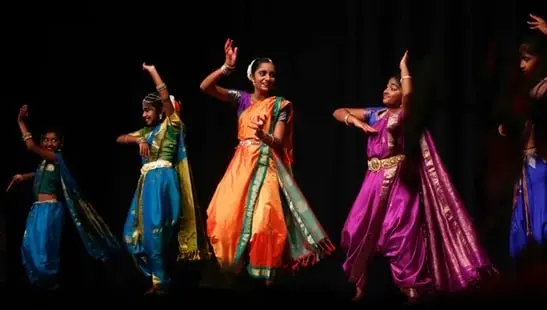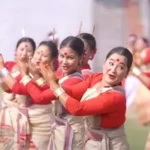Maharashtra is a beautiful state in India, that has long years of cultural harmony in its practices and activities. The dance forms of Maharashtra are truly unique and mind engrossing. The history and culture reflecting on these dance forms, create an amalgamation of entertainment and art. Here let us offer you a short detailed description of all the dance forms now!
Lavani Dance:

Maharashtra’s culture values sensuous lavani dance. Lavani, an 18th-century tradition, has easily merged into official holidays and celebrations. This captivating dance method uses rhythmic feet, subtle hand motions, and elegant costumes to create a breathtaking visual and aural spectacle. Lavani’s love, nature, and society are intriguing. Dancers with bright sarees and rich jewelry swing to Lavani music. Every move and attitude conveys audience feelings throughout the play. Lavani shows rural Maharashtra’s culture. Storytelling maintains cultural tales, rituals, and social critique. Lavani, from Maharashtra, symbolizes the people’s spirit, joys, and sufferings.
Tamasha:
Narration, music, and dancing, all shine in Maharashtra’s Tamasha. This unique state-based art form weaves love, mythology, and societal concerns into a stunning tapestry. Tamasha’s music-dance shows provide compelling tales. ‘Sangeet’ and ‘Bhagwat’ bring these stories to life. They perform on large stages with magnificent clothing that fit their characters, providing the audience an immersive experience. Every performance is energized by Tamasha’s music. Harmonium, dholki, and tabla enhance the story and dancers. The audience feels a range of emotions from the enticing melodies and impassioned rhythms.
Lezim Dance:
The vibrant Lezim dance is a Maharashtra cultural hallmark. The infectious energy and rhythmic rhythms of this flamboyant art form fill festivals, processions, and special occasions. With its cylindrical wooden instruments called ‘lezims’ and colorful costumes, Lezim dance signifies cooperation and joy. Amazing precision and synchronicity in Lezim dance footwork. Elegant dancers use complex motions and rhythms that require skill. The dancers’ synchronized movements and lezims’ rhythmic pulses attract audiences. Lezim dance requires colorful clothes. Dancers’ bright clothes symbolize Maharashtra’s celebratory culture. Traditional clothing ornamentation improves the performance. Clothing enhances dancers’ mobility. Lezim dance is about unity and pleasure, not simply fun. It bonds people during festivals and processions. The energy of a Lezim performance unites the crowd.
Koli Dance:
Koli fishermen and seafarers dwell on Maharashtra’s gorgeous coast. Koli Dance, a vibrant aspect of their culture, reveals their deep sea connection. This lovely dance honors their daily life and maritime past. Koli Dance incorporates Kolis’ everyday life into a colorful performance. Its fishing and rowing boat-inspired movements represent their aquatic life. For realism, Koli dancers bring fishing nets to the stage. This dance’s movement, costume, and props portray Kolis life. Koli dancers’ outfits represent culture. Dancers in Koli costumes reflect their community. Men wear dhotis or kurta-pajamas, while women wear elaborate saris. Koli art and coastal culture are in these garments. Koli dancers add realism with fishing nets. These things enhance the dance’s visual story. Fishing nets symbolize Koli culture’s passion of fishing and sailing, making the performance more than amusement. The dance protects and transmits their culture. It teaches young Kolis about their culture and history. Koli Dance links the past and present, offering its practitioners identity and belonging.
Gondhal Dance:
Maharashtra’s rich culture revolves on gondhal, a dance-drama honoring deities and spirits. Dancers and musicians implore the gods in this interesting art form during religious and cultural events. Gondhal is Maharashtra’s spiritual heritage and a great means to connect with God. Gondhal is honored in religious and cultural festivities when devotees petition deities for benefits. Dance-drama in front of the deity’s idol or sacred shrine is strong adoration. The dancers’ outfits distinguish Gondhal. The performance depicts deities and mythical characters with these garments. Dancers portray deities with ornate headgear and masks. These costumes let viewers relate to strange entities.
Povada Dance:
Povada combines history, mythology, and culture via Lavani dance and storytelling. Maharashtra’s heartland Povada performances tell heroic tales, historical events, and mythology from its rich history. Povada is engaging and educational because dancers narrate stories. Maharashtra’s cultural and historical heritage is preserved by this wonderful dance. Povada dance tells Maharashtra’s epics, history, and culture. Tales of heroic warriors, mythical sagas, historical events, and old morals represent the state’s culture. Povada performances preserve Maharashtra’s stories. Povada dancers employ several moves and facial expressions to depict the story’s emotions, characters, and plot. These cross-linguistic gestures make Povada accessible and intriguing. Audiences relate to characters and circumstances emotionally.
Dindi Dance:
The famed Maharashtra Pandharpur Wari pilgrimage features dindi, a devotional dance. The ‘warkaris,’ pilgrims, who visit Pandharpur to worship Lord Vithoba, inspired this wonderful dance. Dindi dances are soulful with cymbals, drums, and religious music. Dancers carry ‘palakhis’ or palanquins with portraits of Lord Vithoba and Rakhumai, Pandharpur’s guardians, strikingly demonstrating Maharashtra’s spirituality and dedication to the holy. The Dindi dance, a spiritual practice of adoration and devotion, centres this excursion. Warkaris volunteer to dance this spiritual art. They all worship Lord Vithoba and are from different Maharashtra backgrounds. Dindi Dance, a spiritual art form, is included in Pandharpur Wari, a love story. Palakhis, rhythmic beats, and singing reveal Warkaris’ affection for Lord Vithoba and Rakhumai. This dance style represents Maharashtra’s spirituality and reverence for the divine. More than a dance, Indi transforms the spirit through faith and dedication.
Conclusion
The dances of Maharashtra are the elements where tradition and religion mixes up, creating beautiful artistic expressions. For the dance lovers this is a great treat to the senses. The thriving tradition is still offering a great form of entertainment in the National and even International arena.
Related Topics:
Santosh Kumar, the author behind IndiasStuffs.com, is passionate about sharing valuable insights on a variety of topics, including lifestyle, technology, and Indian culture.
Page Contents

